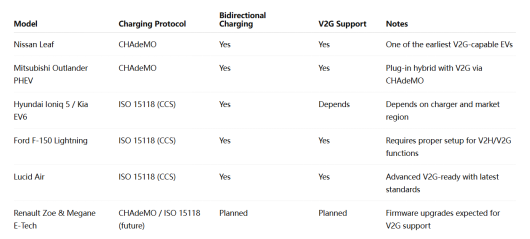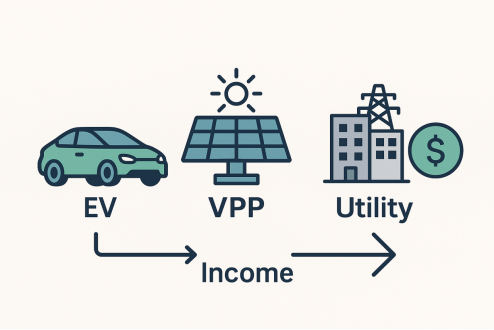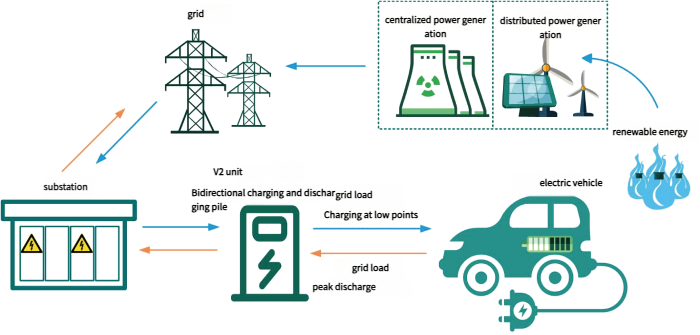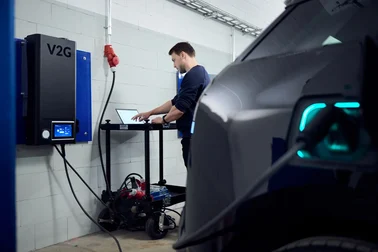Vehicle-to-Grid (V2G) is a breakthrough technology that lets electric vehicles not only charge but also send electricity back to the grid. It helps balance energy demand, support clean energy use, and even generate income. Whether you’re a homeowner or a business, V2G can turn your EV into a smart energy tool.
What is V2G (Vehicle-to-Grid) Technology?
Vehicle-to-Grid (V2G) technology enables electric vehicles to communicate with the power grid in both directions—charging during off-peak hours and discharging electricity when demand is high. By connecting to a bi-directional charger, an EV can serve as a temporary energy reserve, contributing to a more stable grid, optimizing renewable energy use, and offering cost-saving or revenue-generating opportunities for fleet owners and consumers alike. V2G plays a pivotal role in building a smarter, cleaner, and more resilient energy infrastructure.
How Does V2G Technology Work?
Vehicle-to-Grid (V2G) works through a bi-directional energy flow between an electric vehicle (EV) and the power grid. When an EV is connected to a bi-directional charger, the system can either draw energy from the grid to charge the battery or send energy back to the grid from the vehicle’s battery.
V2L vs V2H vs V2G: What’s the Difference
Many have heard of V2L, V2G, and V2H but often confuse their differences.
Vehicle-to-Load (V2L)
V2L enables an EV to power appliances or tools via built-in AC outlets — think camping gear, laptops, or power tools. No bi-directional charger is needed since the vehicle has an internal inverter and accessible plug points.
Vehicle-to-Home (V2H)
V2H uses a bidirectional charger to power homes or buildings from the EV battery—ideal for backup power during outages or for shifting self-generated solar energy. It mirrors home battery systems using vehicle capacity.
Vehicle-to-Grid (V2G)
V2G lets EVs export stored electricity back to the power grid via a bi-directional charger. It supports grid services like peak shaving, frequency regulation, and can generate revenue through feed in tariffs or grid programs.
Comparison of V2L vs V2H vs V2G

Summary:
V2L is the most basic form of vehicle power output, similar to a mobile power bank. It does not require a bi-directional charger.
V2H is a more advanced solution that powers homes or buildings. It requires a bi-directional charger and an isolation mechanism for grid disconnection.
V2G treats the vehicle as an energy asset for the grid. It participates in electricity markets and requires both a bi-directional charger and grid communication protocols.
V2G-Compatible EVs in 2025 (Model List & Standards)
Not all electric vehicles (EVs) currently support Vehicle-to-Grid (V2G) technology. To enable V2G, an EV must have bidirectional charging capability and be compatible with communication standards like CHAdeMO or ISO 15118 (used in CCS).
Popular V2G-Ready EV Models
Nissan Leaf – One of the earliest and most widely supported V2G models using CHAdeMO.
Mitsubishi Outlander PHEV – Also supports V2G via CHAdeMO.
Hyundai Ioniq 5 / Kia EV6 (with updates) – May support ISO 15118 depending on the market and charger compatibility.
Ford F-150 Lightning – Offers bidirectional charging (V2H and V2G capable with proper setup).
Lucid Air – V2G-ready with CCS and ISO 15118.
Renault Zoe & Renault Megane E-Tech – Future firmware upgrades expected to enable V2G.
Comparison Table of V2G-Supported Electric Vehicle Models

Note: Many newer EVs support V2L (Vehicle-to-Load), but true V2G depends on both the car’s onboard system and the charging infrastructure.
Key Requirements of V2G
Implementing Vehicle-to-Grid (V2G) requires more than just a compatible EV. A complete V2G system involves a set of technical and regulatory conditions to ensure safe and efficient energy transfer. Below are the essential components
Bidirectional EV Support
–The EV must support bidirectional charging with protocols like CHAdeMO or ISO 15118.
Bidirectional Charger
–A V2G-capable charger that can both charge and discharge energy.
Communication Protocols
–Compliance with standards such as ISO 15118, OCPP 2.0.1, etc.
Smart Grid Infrastructure
–The local grid must support energy feedback and dynamic control.
Energy Management Platform
–EMS or VPP integration for scheduling and monitoring.
Policy & Incentive Environment
–Local regulations must allow and encourage grid feedback with fair compensation.
Who Can Use V2G Today
Residential EV Owners
Homeowners with V2G-capable electric vehic
Persona Example:
A suburban homeowner with solar panels charges their EV during the day and sells excess power to the grid at peak times, earning energy credits or utility incentives.
Fleet Operators and Commercial Users
Companies operating electric fleets—such as logistics firms, taxi networks, or municipal transport agencies—stand to gain significantly from V2G. These fleets often remain idle for extended periods (e.g., overnight or between shifts), creating ideal opportunities for energy discharge and grid support.
Persona Example:
A delivery company with 40 electric vans connects its fleet to V2G chargers after business hours, reducing peak energy costs and participating in frequency regulation programs.
Solar + EV-Enabled Businesses or Campuses
Organizations with integrated solar systems and EV infrastructure can turn their properties into energy-smart facilities. By combining solar generation with V2G-capable EVs, they can reduce grid dependency, optimize energy flows, and participate in demand response initiatives.
Persona Example:
A tech campus equipped with rooftop solar and EV charging uses V2G to store daytime solar energy in its EV fleet and discharge it during evening peak demand, supporting both sustainability and cost efficiency.
Benefits of V2G for EV Owners, Businesses & the Grid
V2G Benefits for EV Owners
Save on Electricity Costs
With V2G, EV owners can charge their vehicles during off-peak hours when electricity is cheaper, and discharge back to the grid during peak periods when prices are higher. This time-of-use optimization helps reduce electricity bills or generate profits.
Create a New Source of Income
By enrolling in utility-sponsored V2G programs or Virtual Power Plants (VPPs), EV owners can sell stored energy to the grid and receive monthly payments or credits.

Many V2G trials in Europe and Japan already provide real financial incentives to EV owners.
Boost Home Energy Resilience
EV batteries can act as emergency power backup during outages, supplying electricity to essential home appliances. This enhances energy independence and security.
Example:Ford’s F-150 Lightning, when integrated properly, can power a home for up to 3 days.
V2G Benefits for Businesses & Fleets
Lower Operational Costs
Businesses with commercial EV fleets can participate in V2G and reduce energy expenses by discharging power during peak pricing. This is especially valuable for delivery, logistics, and public transportation companies.
A company with 50 EVs can cut electricity costs by thousands annually through grid participation.
Achieve Sustainability Goals
V2G aligns with ESG and corporate sustainability objectives. It helps businesses utilize clean energy more efficiently, reduce emissions, and demonstrate innovation in energy management.
Many large retailers in Europe have begun using V2G-compatible fleets to support carbon neutrality.
V2G Benefits for the Power Grid
Enhance Grid Flexibility & Balance
V2G enables EVs to act as distributed energy resources (DERs), helping the grid respond to real-time demand fluctuations. This reduces the reliance on fossil fuel peaker plants and improves grid efficiency.

V2G is projected to help avoid costly grid upgrades by using existing EV infrastructure.
Provide Frequency Regulation
Grid frequency must stay within narrow thresholds. V2G-equipped vehicles can inject or absorb energy within seconds to maintain frequency stability—faster than most traditional power plants.
TEPCO (Japan) successfully demonstrated V2G’s real-time response for frequency regulation.
How to Join a V2G Program: A Step-by-Step Guide
Verify Vehicle and Charger Compatibility
Ensure your electric vehicle supports bidirectional charging and is compatible with V2G communication standards such as CHAdeMO or ISO 15118. Additionally, you will need a V2G-enabled bi-directional charger installed at your home or facility.
Research Local V2G Programs and Providers
V2G initiatives are typically run by utility companies, energy aggregators, or specialized service providers. Check with your local utility or EV charger manufacturer to find available V2G programs in your area.
Register for a V2G Program
Once you find a suitable program, sign up according to the provider’s process. This may include an application, contract agreement, and possibly a technical assessment of your charging setup.
Install the Required Equipment
If you don’t already have a bidirectional charger, arrange for professional installation. The charger must be compatible with your vehicle and meet the program’s technical specifications.
Set Up Communication and Control
Many V2G programs use apps or web portals to manage charging and discharging schedules. Connect your EV and charger to the program’s platform to enable real-time communication and optimize energy flows.
Understand Compensation and Terms
Review how the program compensates participants—this could be via feed-in tariffs, bill credits, or direct payments. Also, familiarize yourself with any terms regarding battery warranty, energy usage limits, or program duration.
Start Participating and Monitor Performance
Begin using your EV in V2G mode as per the program guidelines. Monitor your energy contributions, savings, or earnings through the provider’s tools and stay informed about any updates.
V2G Challenges and Future Opportunities
Limited EV Compatibility
Only a small number of EV models currently support V2G due to hardware and protocol limitations.
Opportunity & Solution
As automakers adopt standards like ISO 15118, more EVs will feature built-in bidirectional charging. Governments and industry alliances are also encouraging manufacturers to build V2G-ready vehicles.
Example: The Nissan Leaf, Ford F-150 Lightning, and Lucid Air are already V2G-capable.
Need for Bi-directional Chargers
Most charging stations are unidirectional and cannot support V2G.
Opportunity & Solution
Innovative V2G-ready charging stations are entering the market. Incentive programs and pilot projects are encouraging infrastructure upgrades. Early adopters gain a first-mover advantage in energy trading.
Tip: Partnering with V2G hardware providers ensures future-proof installations.
Regulatory & Market Readiness
V2G integration faces unclear regulations and limited commercial models.
Opportunity & Solution
Regulators in the EU, US, and Japan are launching V2G pilot programs and defining technical and commercial frameworks. Virtual Power Plants (VPPs) and demand response markets are becoming viable business models.
Future outlook: Clearer policy will accelerate investment in V2G infrastructure.
Battery Degradation Concerns
Frequent charging and discharging may raise concerns about EV battery lifespan.
Opportunity & Solution
Recent studies show minimal impact when V2G is properly managed. Smart algorithms now optimize charging cycles to reduce wear, and many V2G programs offer battery warranty extensions.
Example: Trials in the Netherlands found no significant battery degradation after 2 years of V2G use.
Conclusion
V2G technology is transforming the energy ecosystem by turning electric vehicles from mere transportation tools into intelligent energy assets. Through bi-directional charging and discharging, EV owners can save on electricity costs by charging during off-peak hours and maximize earnings by feeding power back to the grid during peak times. Businesses and public fleets can significantly reduce operational expenses while supporting green energy and carbon reduction goals with V2G. Although charging infrastructure and vehicle compatibility are still developing, and regulations are evolving, the momentum of V2G technology is strong. It has become a key part of building a smarter, more flexible, and sustainable grid. Now is the perfect time to explore V2G and seize the opportunities of the energy revolution!


